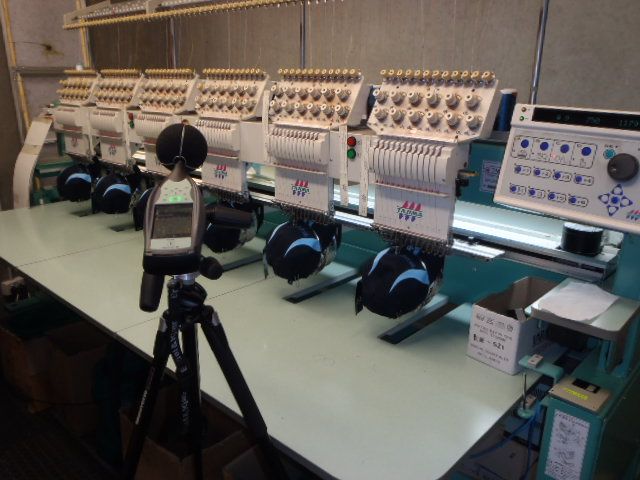The team at NoiseTesting.info were engaged recently to provide a noise assessment of an embroidery factory. The management at the factory were concerned about the workers and whether the noise levels may cause industrial deafness. Noise measurements were carried out within the facility to assess the noise levels within the facility while operational.
Required Noise Testing
The testing that was required to be undertaken was to measure the sound pressure levels of a room where there were embroidery machines operating. The embroidery facility utilises specialty embroidery machines to sew various logo’s onto items of clothing. Within the facility are two embroidery machines, a smaller one with four embroidery positions and a larger one with six embroidery positions. The major noise source is from these machines while operational.
Noise testing officer, Stuart Lumsden had undertaken the noise measurements which were conducted using a Type 1 integrating sound level meter. The choice of sound level meter (SLM) of the NoiseTesting.info team is a Bruel & Kjær 2250. The instrument was checked using a Brüel & Kjær Sound Calibrator Type 4231 (Serial No: 3000818) onsite prior to the noise levels be measured. The Sound Level Meter (SLM) was also checked after the noise level measurements were undertaken to ensure that the recorded noise levels were within the specified calibration limits.
The noise levels were measured at the workers ear position and workplace station position for a minimum of two (2) cycles of the activity being undertaken, being generally for 5 minutes or longer. In this instance the embroidery machines were operating at different times which may slightly affect the overall noise testing results. The noise levels also depended on the type of embroidery that was to be done.
The area assessment testing indicates that the noise levels are significantly below 85 dB(A) and is not considered a noisy environment. The maximum A weighed sound level measured was located behind the 6 position embroidery machine along the wall of the room at 80.6 dB(A). The dB(C) peak measurements were less than 140 dB(C) and as such there is a negligible risk of acoustic shock.
Noise Levels Measured within the Embroidery Facility
The general noise levels measured within the embroidery facility were found to be between 67.2 and 80.6 dB(A) in this particular instance. It is only that the embroidery facility had had the noise assessment conducted that they were able to determine whether hearing protection was required. In other instances embroidery machines may be over the 85 dB(A) and hearing protection along with other noise controls may be required.
If you have a manufacturing facility and have not as yet had a noise assessment undertaken then you may not know the level of risk and potential compensation that may be obtained by employees. Don’t let this happen to you and ensure that the noise levels within the workplace are documented to either provide effective controls or document that the risk is negligible.
If you have a manufacturing facility and are unaware of the noise levels, please contact safe Environments to undertake a noise assessment in line with the Australian Standards to minimise the risk or workers developing industrial deafness.
Author: Carl Strautins

Email: Carl@SafeEnvironments.com.au
Carl Strautins is a managing director of Safe Environments Pty Ltd a multi-specialist consultancy operating in the building, construction and property management industries. He provides the necessary guidance and risk minimisation strategies required by architects, construction companies and facility managers to ensure they mitigated their risk to property risk. He is engaged on a regular basis to provide expert opinion for disputes and legal proceedings. Click here to know more about him.


